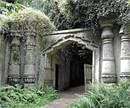

It’s overgrown and old, and it’s the type of place you’d only be seen dead in. It’s a cemetery. It’s not any cemetery though. It’s Highgate Cemetery. This iconic resting place in London probably has more famous dead people per square metre than anywhere else in the world. What’s more the place is a monument to Victorian era tombstone culture.
I first visited Highgate Cemetery in the mid-1980s, when Margaret Thatcher was taking on the last bastion of organised militant labour, the mineworker's union, led by its dyed in the wool Marxist leader Aurther Scargill. There was more than a hint of left wing radicalism in the air, so it seemed quite apt to visit the grave of Karl Marx. To my surprise, however, I found the cemetery to have a lot more going for it than just Marx’s tomb.
Consecrated by the Bishop of London in 1839, Highgate has 52,000 headstones with 166,000 names engraved on them. It became the desirable resting place of fashionable Victorian society, and it certainly shows.
A treasure trove of decadent Victorian deathly delights, its numerous tombs and gravestones reflect grand Victorian taste in every sense and embody all of the pomp and circumstance that the Victorian upper class revelled in.
With three storey high catacombs, Egyptian sepulchers and a plethora of imposing stone angels, Gothic tombs and buildings, Highgate is an overlooked gem on the London tourist circuit.
Poets, painters, writers, princes and paupers are all buried here. Highlights of the romantic wilderness of catacombs and monuments include the Egyptian Avenue, which is approached via a shaded woodland path. An obelisk and lotus-flower column mark the entrance, and the avenue itself could be straight out of an Indiana Jones movie.
It is essentially a street of family vaults, based on the style of ancient Egyptian tombs, and the Circle of Lebanon, a ring of vaults topped by a cedar tree.
Highgate Cemetery’s most famous resident is of course Karl Marx, whose ideas, however used or misused, shaped much of the 20th century. A huge bust of him rests upon a massive plinth, with an inscription urging the workers of the world to unite.
Various leaders of Soviet Russia visited Marx’s grave and the communist party leaders of other countries are buried in the cemetery, next to their ideological leader. They include Saad Saadi Adi, the Iraqi communist leader, and Dr Yusef Mohamed Dadoo, Chairman of the South African Communist Party.
The somewhat dishevelled looking sextant, who going by appearance may well have spent most of his life living in the cemetery, took me to some nondescript and overgrown place where Marx had originally been buried.
He was subsequently dug up and put in a more prominent place. But if Marx and his concept of dialectical materialism send you to sleep, don’t despair. Philosophers from various backgrounds have made it into the cemetery.
Ironically, famous British sociologist Herbert Spencer is buried just metres from Marx. Ironic, because his brand of social philosophy is diametrically opposed to Marx’s.
If Marx helped to shape the political landscape from Warsaw to West Bengal and from Kerala to Cuba, Spencer’s philosophy underpinned much of the politics of Reagan, Thatcher and George W Bush.
Although Spencer’s tortuous ramblings about the theory of ‘acquired cultural characteristics’ may have you reaching for the arsenic, you can take comfort in the fact that novelist George Elliot, scientist Michael Faraday and composer Edward Elgar are all buried here.
Indeed, the whole place teems with movers and shakers of British, western and world culture, including eccentric traveller James Holman, who roamed the globe in the early 19th century despite being completely blind, Elizabeth Siddall, a famous Pre-Raphaelite model, William Friese-Green, the first man to make moving pictures on celluloid, and Peter Heywood, the unfortunate midshipman on the HMS Bounty, who was wrongly convicted and sentenced to death for his part in the mutiny. The famed Orientalist and translator Arthur Waley and the notorious lesbian novelist Marguerite Radclyffe-Hall are also here.
The cemetery is a rambling expanse of greenery in the heart of north London. Urban foxes roam freely and share the habitat with some 50 species of birds and 18 of butterfly, which can be spotted among the hornbeam, exotic limes, oak, hazel, sweet chestnut, field maple and tulips. The atmosphere is impressively gothic, and, in many ways, the place could form the backdrop to a horror movie, with its imposing crucifixes, giant angels and other assorted icons of the Christian afterlife.
If what is required is a good old slice of typical English eccentricity, you could do much worse than paying a visit to Highgate Cemetery.